Metropolitan Water Reclamation District of Greater Chicago Completes Another Link In Its Tunnel And Reservoir Plan
By Allison Fore, Public and Intergovernmental Affairs Officer, and Patrick Thomas, Public Affairs Specialist
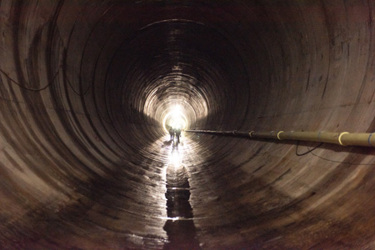
Despite a frightening global coronavirus pandemic threatening the health and safety of workers everywhere, construction is moving forward.
At 270 feet below the earth’s surface, the Metropolitan Water Reclamation District of Greater Chicago’s (MWRD’s) Des Plaines Inflow Tunnel (DPIT) is eerily dank, dark, and cool, but it is a vital piece of a puzzle and last mile of tunneling that will address an ongoing battle against flooding and water quality protection. High above in a world facing the coronavirus pandemic, the Chicago area is occupied by impervious and flat terrain. Coupled with aging local sewer systems that were designed more than a lifetime ago to overflow into local waterways, the flooding threatens water quality and the environment. This final mile of underground construction provides a light at the end of the tunnel and a new link to MWRD resilience.
Water Finds A Way
Alarming rates of rainfall have given more reason for major infrastructure projects like the MWRD’s Tunnel and Reservoir Plan (TARP). The MWRD’s system of deep, large-diameter tunnels and vast reservoirs are designed to reduce flooding and improve water quality in Chicago area waterways and protect Lake Michigan, the source of the region’s drinking water. The system’s large capacity prevents combined sewer overflows (CSOs) from entering waterways and keeps water from reversing course into Lake Michigan. TARP’s vast storage system gives the MWRD’s water reclamation plants time and capacity to keep up with treating stormwater and wastewater during heavy rainfalls.
Unprecedented rain totals are on the rise. When Chicago rainfall records were shattered for the month of May in 2019, the 8.25 inches of rain surpassed a record of 8.21 inches that fell during none other than the previous May in 2018. That is an increase of almost 5 inches from the 3.68-inch average for the month of May, according to the National Weather Service (NWS). Over the entire spring of 2019, the NWS reported that approximately 16.36 inches of rain fell in Chicago, accounting for the city’s second-wettest spring since the weather service began tracking rainfall in 1871. If this trend escalates, the battle-tested TARP system will rely heavily on the MWRD’s other new creation, the McCook Reservoir. The DPIT provides an important link to convey one of two tunnel systems to the reservoir, and once complete, this will become the world’s largest combined sewer reservoir, large enough to hold an astounding 10 billion gallons (BG) of water.
McCook Reservoir: A Bastion Of Relief
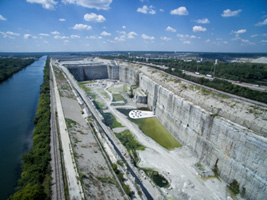
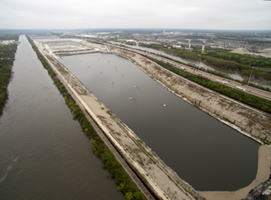
An empty Stage I of McCook Reservoir compared with a filled reservoir shows the magnitude of 3.5 billion gallons of water. Off in the distance, Stage II will provide an additional 6.5 billion gallons of storage by 2029.
Completed in two stages, the reservoir’s first section, equipped to store 3.5 BG, came into service in late 2017. To mine the reservoir, the MWRD contracted with Vulcan Materials in October 2003, and full production began in March 2008. Ten years later, the reservoir has proven its value, capturing more than 52.4 BG of water in its first two years alone. Combined with the Mainstream (21.5 BG) and Des Plaines (14.2 BG) tunnel systems, the McCook TARP system captured more than 88.15 BG of combined sewage and stormwater that previously would have overwhelmed systems and overflowed into rivers or backed up into area basements and streets. The completed reservoir will provide more than $143 million per year in flood damage reduction benefits to 3.1 million people in 37 communities.
“You think about that amount of water and where it could have ended up without this system in place and you realize the enormity of this project,” said MWRD Board of Commissioners President Kari K. Steele. “The Tunnel and Reservoir Plan is paving the way for us to mitigate pollution and flooding from large, consecutive rain events, protecting homes and businesses, and our rivers and drinking water supply in Lake Michigan. This is critical infrastructure that protects our environment, the economy, and our way of life, and we are one mile away from connecting our last tunnel to the reservoir.”
The MWRD estimates the tunnel system by itself captures 85 percent of the CSO pollution load. Since Stage I of McCook Reservoir went into service in late 2017, the percent of CSO capture has risen and the amount of CSO volume has declined. This can be attributed to the addition of the reservoir. TARP captures the heavily polluted first flush of combined sewage from storms and continues to capture diluted sewage mixed with stormwater throughout each storm until capacity is reached. The water captured by McCook is eventually pumped to Stickney Water Reclamation Plant for treatment. In 2019, the MWRD pumped back 54.46 BG for treatment from the tunnels and reservoir. Even more water will be captured when McCook Reservoir Stage II comes into service. To date, 38 percent of Stage II of the reservoir has been mined, equating to approximately 55 million tons of rock removed. The rock mined is crushed onsite and transported by conveyer under the reservoir and the Des Plaines River to an existing quarry where it is processed and sold to be used for concrete and other construction purposes.
The Missing Link
If constructing a cavernous reservoir out of 400-million-year-old limestone weren’t daunting enough, this final stretch of tunnel presents one more challenge to conveying water. This mile-long subterranean passage represents the final leg on a grueling trek of construction that connects to the 25.6-mile Des Plaines Tunnel System. It is the last mile of TARP tunnels connecting the McCook Reservoir to the MWRD’s labyrinth system of tunnels that in total extend 110 miles long and 240 to 300 feet below ground. These tunnels and three adjoining reservoir systems provide relief for more than 3.5 million people living in a 352-square-mile area of combined sewer systems, collecting both sanitary sewage and stormwater.
The DPIT and McCook Reservoir Stage II are the last hurdles the MWRD finds itself addressing to complete the entire TARP. Envisioned more than five decades ago, TARP was the MWRD’s response to heightened water quality standards and flood mitigation. In the process, TARP became one of the largest public works projects in the world dedicated to water quality improvements. But constructing more than 100 miles of deep tunnel 300 feet below ground and mining a series of massive reservoirs takes time. Despite a frightening global coronavirus pandemic threatening the health and safety of workers everywhere, construction is still moving forward but with additional workplace precautions in place, including six-foot social distancing, wearing face masks, and taking temperatures before each shift. The MWRD is on schedule to complete the tunnel connection by 2021 and the reservoir by 2029 to create a total of more than 17 billion gallons of storage capacity.

The Des Plaines Tunnel transitions from 33 feet in diameter to 20 feet, where it will connect from the inflow tunnel to the McCook Reservoir.
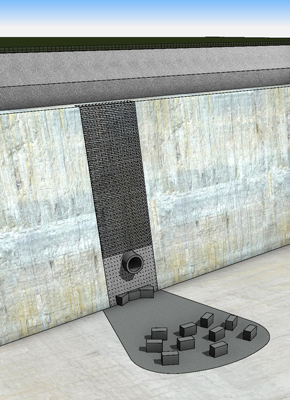
The tunnel transitions down from a diameter of 33 feet in the existing Des Plaines tunnel to the 20-foot inflow tunnel, which ultimately reaches the reservoir. In order to create the inflow tunnel, the MWRD’s contractors blasted through more than a mile of limestone.
At the north end of the DPIT, a 280-foot deep, 11-foot diameter construction shaft was built to provide access to the DPIT construction and the live connection to the existing tunnel, which is separated by a 18-foot-thick reinforced concrete plug. Here in the shaft, workers are lowered via a cage-like container hoisted by crane. In the middle of the tunnel, another larger shaft, 45 feet in diameter was constructed. Here, more workers are lowered in to prepare for the installation of primary and backup gates that are 270 feet below ground.
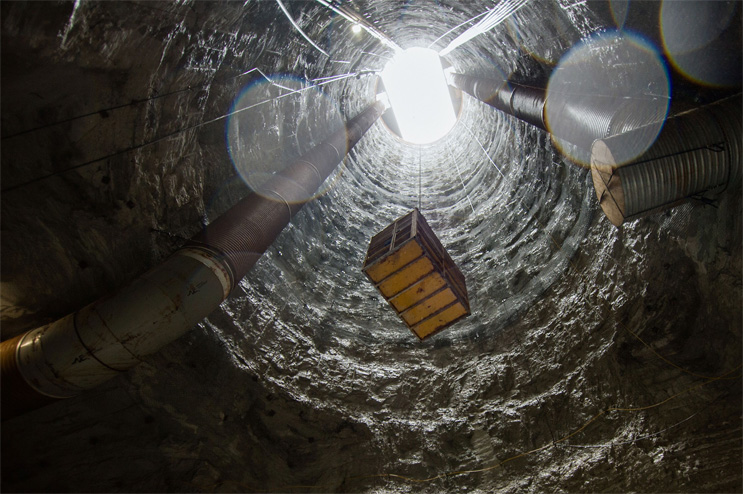
Workers are raised and lowered into the Des Plaines Tunnel via a cage-like container hoisted by crane.
Light At The End Of The Tunnel
With the excavation and concrete lining of the mile-long tunnel complete, the MWRD is now completing the installation of the gate structure and gate control building and associated equipment. The MWRD plans to install a high head primary gate and backup gate, both approximately 16 feet wide and 20 feet tall. Then two concrete plugs will be demolished using controlled blasting under live tunnel conditions. That work requires workers to evacuate anytime there is a threat of a storm. It may sound like a daring mission, but after creating more than 100 miles of tunnels, the MWRD has gained experience along the way. Once complete, the existing Des Plaines Tunnel will be directly connected to Stage I of the McCook Reservoir.
The tunnels have made an incredible difference. Area water quality has been improving since the Phase 1 tunnels began operation in the mid-1980s, and again in 2006 once they were completed. During that time, the numbers of CSOs were reduced from an average of 100 days per year to 50. The MWRD added the Thornton Composite Reservoir in 2015. Since the 7.9-BG reservoir south of Chicago was brought into service to aid Chicago and 13 nearby south suburbs, CSOs in the Calumet River System have been virtually eliminated. McCook Reservoir, which is serving a larger swath of land, is already delivering. But once the second stage is in operation, it is also expected to make a major difference in improving water quality and mitigating flooding.
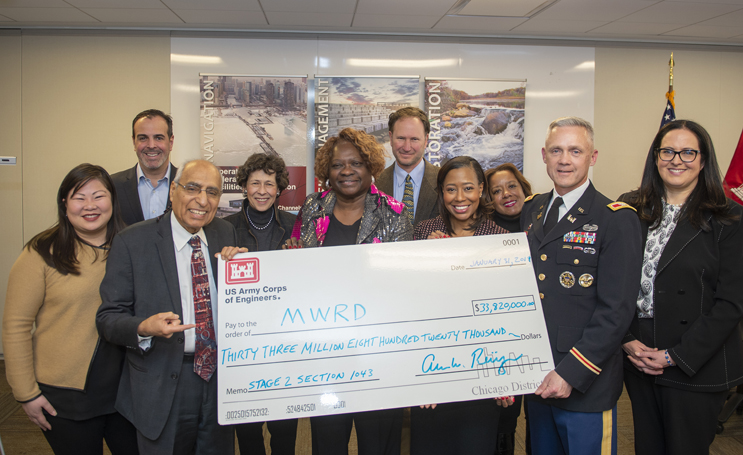
Members of the MWRD Board of Commissioners were presented with a ceremonial check for $33.8 million from USACE Commander Aaron Reisinger which will help the MWRD carry out final construction of TARP, including the second stage of McCook Reservoir.
These final TARP projects are taking place due in part to a new pilot program created in partnership with the U.S. Army Corps of Engineers (USACE). The pilot program, which USACE had never implemented previously, allows the local sponsor of a USACE project to take over responsibility for completing construction. In 2019, the MWRD and the USACE Chicago District announced that they had executed a partnership agreement that secured $33.8 million from the federal government to help the MWRD complete McCook Reservoir Stage II. This lump sum payment to the MWRD came as a result of the Water Resources Development Act of 2014.
Digging Holes Is Only Part Of The Solution
In addition to its three TARP reservoirs, the MWRD also owns and operates 34 stormwater detention reservoirs, but the MWRD realizes that the many holes buried below ground are not a panacea to managing stormwater and improving water quality. TARP can create jaw-dropping images of dimly lit, winding tunnels and sky-high reservoir walls, but digging holes is not the only solution to solving water capacity issues in the Chicago region. As the regional stormwater authority for Cook County, the MWRD has implemented a wide range of policy and programs to manage stormwater since taking on the role in 2004.
The MWRD adopted a critical Watershed Management Ordinance (WMO) in 2013, abating the negative impacts of stormwater runoff resulting from new development or redevelopment. The WMO regulates sewer construction within MWRD’s service area and development within suburban Cook County. It provides uniform stormwater management regulations to prevent future commercial, municipal, and residential development and redevelopment projects from exacerbating flooding and protects environmentally sensitive areas. The WMO requires the first inch of rain to be captured using green infrastructure on new property development. In a few short years, it has provided more than 520 million gallons of total detention.
Through the MWRD’s Flood-Prone Property Acquisition Program, the MWRD has entered into intergovernmental agreements with several communities to acquire flood-prone properties. The voluntary program rescues homeowners and communities from desperate situations and returns the flood-prone properties to passive spaces. The agency has also increased its commitment to use green infrastructure to help reduce flooding and decrease the load on the local sewer system. In 2015, the MWRD adopted a Green Infrastructure Plan to increase the acceptance and investment of green infrastructure throughout Cook County. Recognizing its valuable and integral partnerships with local governments, the MWRD has partnered with dozens of agencies to fund shovel-ready projects like the installation of green and gray infrastructure, stormwater storage, storm sewer and culvert upsizing, improvements to pump stations, and the establishment of drainage ways.
The MWRD has invested heavily in local green infrastructure projects, such as rain gardens, bioretention areas, permeable pavement systems, and rainwater harvesting systems. Together with these partners, the MWRD has completed 38 green infrastructure projects to date, designed to store more than 8 million gallons per rain event. In late 2019, the MWRD selected 20 new green infrastructure projects to fund as part of an annual call for projects. This is in addition to 38 other project partnerships the MWRD selected in 2017 and 2018.
The use of green infrastructure represents a cultural shift to encourage the public to absorb water on their own properties. While the MWRD constructs gray infrastructure projects, the use of rain gardens and permeable pavers would complement these efforts. In 2019, the MWRD and local agencies and non-profit partners completed their 20th schoolyard transformation, converting asphalt playgrounds at Chicago Public Schools into vibrant places to play and learn through a program called Space to Grow. The partnership has already captured more than 3.65 million gallons of water per rain event, equivalent to 5.5 Olympic-sized swimming pools, and educated a new generation on the power of green infrastructure.
The MWRD has also distributed more than 130,000 55-gallon rain barrels and more than 70,000 free oak tree saplings to offset the regional loss of ash trees and soak up more stormwater. This year, the MWRD rolled out a Green Neighbors Guide to empower property owners to play a role in battling excess water flow that has arisen in part to climate change and increasingly intense and unpredictable precipitation.
Signs Of Success
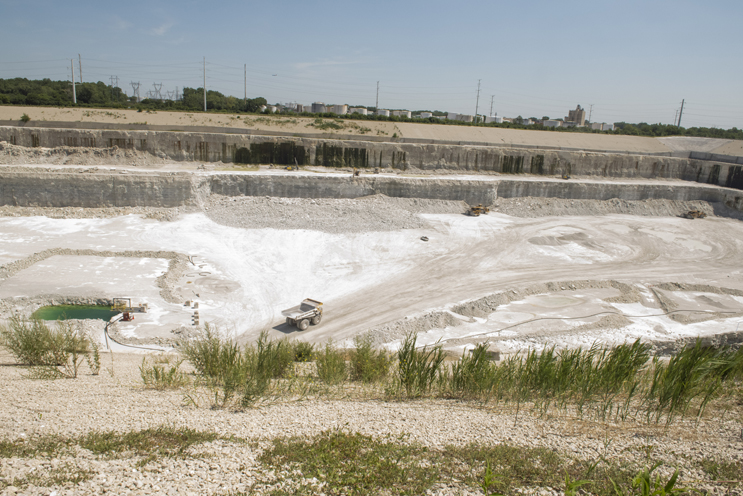
McCook Reservoir Stage II is being mined to create more capacity for the MWRD. Approximately 55 million tons of rock have been removed, as more than 60 percent of the mining work still awaits.
Green infrastructure is typically considered in the context of flooding. But in the combined sewer systems that the MWRD serves, it also promotes water quality. If TARP can absorb more of the first flush of what was formerly CSO pollution, it can provide the MWRD’s treatment plants more time and space to manage the influx of water leading to cleaner waterways and an improved water environment. With the addition of McCook and Thornton reservoirs, the MWRD has taken another step further to nearly eliminating CSOs. Because of these advancements, the region has seen tremendous ecological recovery of the Chicago Area Waterway Systems (CAWS) during the implementation of TARP. From the MWRD’s first critical assignment in the late 19th century to reverse the flow of the Chicago River and construct more than 61 miles of canals, the water quality experienced today could not have been envisioned. TARP has contributed to measurable declines in wet weather concentrations of biochemical oxygen demand and suspended solids, meaning improved dissolved oxygen levels in the water that have resulted in healthier waterways. At the same time, aquatic life has flourished.
The MWRD’s Monitoring and Research Department has documented water quality improvements to Chicago area rivers and streams. Part of that water quality data includes fish populations, dissolved oxygen levels and other water chemistry data that show signs of a healthy water quality. The number of fish species found in the CAWS, for example, has drastically increased since the 1970s when monitoring of the fish population first began. From 10 known species in 1974, that number has ballooned to 77 by 2020, including 60 that have been found in the CAWS since 2000. Thanks in part to advancements of TARP and at MWRD water treatment operations, the waterways have experienced new life, a surge in recreational activity and economic development.
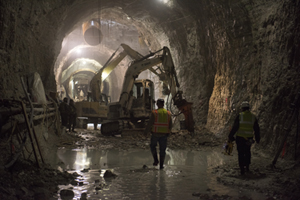
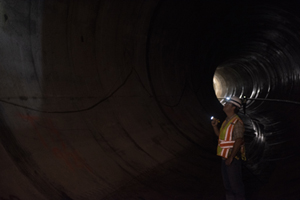
Construction of the Des Plaines Inflow Tunnel began with removal of limestone rock, followed by the interior lining of concrete that will keep water from escaping the tunnel. A concrete plug keeps workers dry, separated from the live tunnel.
Hidden underground and miles away from the main stem of the colorful Chicago River and Chicago Riverwalk that will one day soon again be flourishing with boaters and visitors, it is this last stretch of the Des Plaines tunnel connection that will provide a critical missing link to another century of healthy waterways and reprieve from flooding concerns. After constructing more than 109 miles of deep tunnel, this final mile represents the culmination of countless hours of dedication to water quality improvements. And as the MWRD draws closer to the light at the end of tunnel, the Chicago region will be more resilient and ready to face the impacts of an ever-changing climate and ever-changing pandemic.
